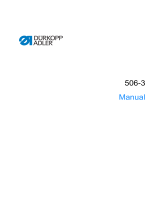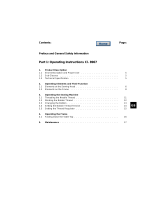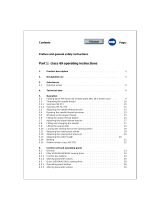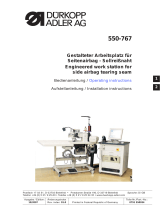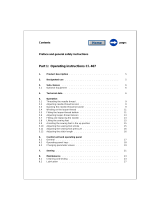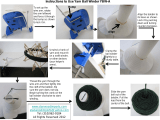Page is loading ...

Contents Page:
Preface and General Safety Information
Part 1: Operating Instructions Cl. 506
1. Product Description
1.1 Description of the Proper Use and Proper Application . . . . . . . . . . . . . . . . . . . . . . . 5
1.2 Short Description . . . . . . . . . . . . . . . . . . . . . . . . . . . . . . . . . . . . . . . . . . . . 5
1.3 Technical Data . . . . . . . . . . . . . . . . . . . . . . . . . . . . . . . . . . . . . . . . . . . . . 6
2. Operation
2.1 Automatic Sewing Sequence . . . . . . . . . . . . . . . . . . . . . . . . . . . . . . . . . . . . . 7
2.2 Needles and Yarns . . . . . . . . . . . . . . . . . . . . . . . . . . . . . . . . . . . . . . . . . . . 9
2.3 Threading the Needle Thread . . . . . . . . . . . . . . . . . . . . . . . . . . . . . . . . . . . . . 10
2.4 Changing the Bobbin . . . . . . . . . . . . . . . . . . . . . . . . . . . . . . . . . . . . . . . . . 12
2.5 Thread Tension . . . . . . . . . . . . . . . . . . . . . . . . . . . . . . . . . . . . . . . . . . . . . 14
3. Bobbin winder
. . . . . . . . . . . . . . . . . . . . . . . . . . . . . . . . . . . . . . . . . . . . . 15
4. Maintenance
4.1 Cleaning . . . . . . . . . . . . . . . . . . . . . . . . . . . . . . . . . . . . . . . . . . . . . . . . 16
4.2 Lubrication . . . . . . . . . . . . . . . . . . . . . . . . . . . . . . . . . . . . . . . . . . . . . . . 17
Home


1. Product Description
1.1 Description of the Proper Use and Proper Application
The 506 is a robust, heavy-duty, curve-guided single needle doulble
saddle stitch short seam unit for seams of stitch type 301.
This short seam unit is designed for use in sewing heavy-weight fabric,
as well as thick and hard leather.
Thick and hard leathers find use in the sewing on of trim pieces, in the
sewing of buckle caps, tabs, suitcases, tarpaulins, knapsacks and
backpacks.
Heavy-weight fabrics are used in the sewing of heavy-duty carrying
belts, car belts, as well as belts for aviation.
Generally only dry sewing material may be worked with this machine.
The material may be no thicker than 16 mm when pressed together by
the lowered clamping feet.
The machine must be operated with eye protection. The information to
be found printed on the yellow sign on the head cover is to be strictly
adhered to.
The seam is generally made with synthetic sewing yarns with a
dimension of 30/3 to 8/3. Those wishing to use other threads must first
evaluate the dangers arising therefrom and, if necessary, take safety
measures.
This heavy short seam unit may only be installed and operated in dry
and clean areas. If the unit is used in other areas, which are not dry
and clean, further, to be agreed upon, measures may become
necessary (see EN 60204-3-1:1990).
We, as manufacturer of industrial sewing machines, presume that the
operating personnel working on our products have been given
instruction so that all normal operations and the dangers possibly
arising therefrom can be assumed to be known.
1.2 Short Description
Uniform Quality
The unit always produces a uniform seam formation.
The high thread tension necessary for the working of heavy materials
is achieved through a hinged thread lever.
Direct Power Transmission
The power transmission from the motor to the arm shaft occurs via a
special V-belt. This results in a particularly strong perforating power
for the sewing of thick materials or multiple layers.
Interchangeable Curve Disks and Material Clamps
The different seam formations are determined by easily
interchangeable curve disks.
The material guidance occurs via a pattern curve with two guide
curves. The difficult and time-consuming turning of heavy pieces of
material by the seamstress is thus unnecessary.
The transmission of the movement to the material clamps occurs via
lever systems. By changing the lever multiplication the seam formation
sizes can be varied within certain limits.
All curve disks belonging to a stitch number range are interchangeable
among each other.
Large Put-through Area and Large Placement Surface
The large put-through area allows the making of short seams far from
the edge of the material. A rolling-in of flexible sewing material is
possible. The closed width base plate offers a large placement surface
and simplifies the feed.
5

Pneumatic Clamp Opening
The stroke of the holder clamp is a maximum 20 mm. This stroke allows
the working of almost all sewable materials and leather thicknesses.
Electric Thread Burning Device
The thread separator device separates the needle and underthread by
burning immediately at the top edge of the material. The synthetic
threads are melted together at the ends. The thus created hardening
hinders a loosening of the seam and a unthreading of the needle thread.
MICROCONTROL Controls
The complete control of the sewing unit occurs via a microcomputer. It
assumes the control tasks, monitors the sewing process and indicates
operator errors and malfunctions.
1.3 Technical Data
Sewing area: maximum 60 x 100 mm
Needle system: 428; 428 Serv Nm 250;
794 (for thick sewing material only)
Needle thickness: Nm 120 - Nm 280
depending on the type of sewing thread
and the sewing material.
Yarns: Synthetic yarns
Nm 30/3 - 8/3
Bobbin capacity: 23 m with 18/3 yarn
Stitch type: Double saddle stitch type 301
Number of stitches: 1100 / min
Number of stitches per 42, 58, 72 (without gear reducer)
guide curve revolution: 84, 116, 144 (with gear reducer)
Seam formation 72 stitches in 3.5 sec. or
144 stitches in 7 sec.
Looping stroke: 5 mm
Clamp stroke: max. 20 mm
Sewing material thickness: max. 16 mm (sewing material pressed
together by the clamp)
Power: 0.55 kW
Motor rpm: max. 2800 rpm
Operating pressure: 6 bar
Air consumption: approx. 1,2 NL per work cycle
Nominal voltage: 9880 506001 3~380-415 V + N, 50 Hz
9880 506002 3~220-240 V, 50 Hz
9880 506003 3~220-240 V, 60 Hz
The unit is supplied with one of the
listed voltage kits appropriate to the
nominal voltage.
Dimensions: (H x W x D) 1720 x 1100 x 736 mm
The listed height dimension applies to
the work height of the frame set at the
factory.
Put-through area: 210 x 140 mm
Work height: 760...1060 mm (upper edge of the table
top)
Weight: 160 kg
Noise level Lc: 83 dB (A)
Workstation related emission according to DIN 45635-48-B-1
Number of stitches: 1.000 min-1
Commanding cam: (Stitches) 116
Sewing cycles: 9,7 s on / 2,0 s off
Sewing material: 2x girdle tape 1,5 mm 1.260 g/m
2
Measuring point to DIN 4895 Part 1
X = 0 mm Y = -400 m Z = 300 mm
6

2. Operation
2.1 Automatic Sewing Sequence
ATTENTION !
Before commissioning it is essential that the number of stitches per
curve disk revolution be set at the internal DIP switch (b500) of the
controls appropriate to the curve disk used (see Part 4: Short
Description Multicontrol).
The starting of a sewing sequence is only possible with the head cover
and cover 3 for the hook area closed.
If the head cover or cover for the hook area is open all functions of the
controls are blocked.
Work procedure
(in foot switch mode 1)
–
Turn on the motor protection switch 1 under the table top.
It normally remains turned on constantly.
–
Turn the main switch 2 on.
The clamps are in their upper position.
–
Select sewing program.
–
Align the sewing material under the clamps.
Depending on the type of work sequence this can occur according
to the markings or the stops mounted specifically for the customer.
Caution Risk of Injury !
Keep hands free of the lowering clamps.
–
Operate the right foot switch 5.
Both clamps lower simultaniously.
–
Check the correct alignment of the sewing material.
To correct the sewing material alignment operate the right foot
switch again.
Both clamps rise.
–
Operate the left foot switch 4.
The automatic sewing sequence starts.
1
2
3
4
5
7

–
For a secure sewing-on draw the thread end hanging out of the
needle taut to the side when starting the
first
sewing sequence
and hold tight.
After the first stitches the thread can be released again.
–
The automatic sewing sequence runs through according to the
selected sewing program (P01 - P03).
For an exact description of the different sewing programs see Part
4 "Short Description Multicontrol".
–
After the sewing sequence ends the clamps are raised
automatically.
–
Remove the sewing material.
Quick stop
The safety system of the 506 has two different options for the
immediate shut-off of the unit by operator error, needle breakage,
thread breakage etc.:
–
Pressing the
Stop
key 1 on the front panel of the controls.
The sewing sequence is interrupted.
The thread lever moves to the high position.
–
Pressing the
Stop
key 2 on the head cover.
The sewing sequence is interrupted.
The thread lever moves to the high position.
To continue the sewing sequence:
–
Operate the left foot switch.
1
2
8

2.2 Needles and Yarns
Needle system: 428; 428 Serv Nm 250; 794
(depending on the type of sewing thread and sewing
material used)
Needle thickness: Nm 120 - Nm 280
(depending on the type of sewing thread and sewing
material used)
Yarns: Synthetic sewing yarns (30/3 to 8/3)
Changing the needle:
Caution Risk of Injury !
Turn the main switch off.
Change the needle only with the unit turned off.
–
Open the head cover.
–
Loosen screw 1.
–
Remove the needle.
–
Push the new needle into the hole in the needle bar up to the stop.
Hereby align the needle with the furrow 3 to the hook.
The furrow 2 must show to the front (to the seamstress).
–
Tighten screw 1.
Attention Danger of Breakage!
After a change to a needle with a different needle thickness it is
essential to check the clearances
hook point-needle
and
driver-needle
.
If neccessary reset the clearances (see Part 3: Service Instructions).
1
2 3
A
A
A-A
9

2.3 Threading the Needle Thread
Caution Risk of Injury !
Turn the main switch off.
Thread the needle thread only with the unit turned off.
The threading of the needle thread occurs as shown in the pictures
alongside in increasing numerical order:
–
Place the yarn roll on the yarn stand.
–
Thread the thread through the holes 1 of the yarn stand.
–
Thread the thread through thread guide 2.
–
Lead the thread through between the tension disks of the first
needle thread tension 3.
–
Thread the thread consecutively through thread guides 4 and 5.
–
Guide the thread through between the tension disks of the second
needle thread tension 6.
–
Thread the thread consecutively through the hole in the thread pull
7 and thread guide 8.
–
Wind the thread from the bottom approx. two times around the
thread roller 9.
–
Guide the thread through the thread controller spring 10.
–
Guide the thread under the thread guide 12.
–
Open the head cover.
–
Thread the thread through the hole in the thread lever 13.
–
Guide the thread through the hole in the thread control plate 14.
–
Insert the thread from the side into the thread gripper 15.
–
Thread the thread through the thread guide 17 on the needle bar.
–
Thread the thread from the front to the back through the eye of the
needle.
1
10

2.4 Changing the Bobbin
Remove the empty bobbin
–
Press the " " key.
For better accessability by the seamstress a second key with the
same function is to be found at the left on the head cover.
–
Hold the cover 4 and push the arresting lever 1 up to unlock the
cover.
–
Tilt cover 4 to the front.
ATTENTION !
Cover 4 is monitored by the safety switch 5.
With the cover open all functions of the controls are blocked.
Starting the sewing sequence after a change of bobbin is only possible
with the cover closed.
–
To swing the bobbin case 3 out press the ejector lever 2 to the left.
–
Remove the empty bobbin from the bobbin case.
1 2 3 4 5
12

Inserting a full bobbin
–
Place the full bobbin in the bobbin case 2.
Here take care that when thread is being pulled off the bobbin
must turn
counterclockwise
(see the arrow direction)!
–
Swing in the bobbin case 2.
–
Pull the thread through the slot 1 into the opening 3 on the spring 4.
ATTENTION !
A thread sliding out of slot 1 can lead to missing stitches
and needle breakage.
Therefore pull the thread so far through slot 1 until it lies secure in the
opening 3 on the spring 4.
–
Pull the thread approx. 5 cm out of the bobbin case.
–
Close the cover.
–
Start a new sewing sequence.
1 2 3 4
13

2.5 Thread Tension
Set the thread tensions appropriate to the yarn types and
thicknesses used so that a clean seam formation results.
Too high thread tensions cause a crimping of the sewing material. Too
low a bobbin thread tension can lead to missing stitches.
Setting the needle thread tension
–
Set the upper needle thread tension by turning the knurled screw 1
and the lower needle thread tension by turning the knurled screw 2.
Setting the bobbin thread tension
–
Loosen the fastening screw 3.
–
Set the bobbin thread tension by turning the setting screw 4.
–
Tighten the fastening screw 3.
3
4
1
2
14

3. Bobbin winder
Reeling on the spool thread
–
Place yarn reel on reel stand.
–
Thread the thread through the holes 1 in the reel stand.
–
Pass the thread through the tension discs of tensioner 2.
–
Pass the thread through the tension discs of tensioner 3 of the reel.
–
Pass the thread through the slot in guide 4.
–
Pass the thread through the hole 7 in the empty reel.
–
Place the empty reel on the bobbin shaft 8.
The pin 10 of the bobbin shaft must fit into the hole 7.
–
Pass the thread through the star 10 and clamp it in the tensioner 11.
–
Use the thread clipper 6 to cut off the end of the thread.
–
Raise the thread layer 5.
The bobbin winder is switched on and the winding process begins.
–
As soon as the reel is full the thread layer 5 springs back into
position and the winding process is terminated.
23 456
1
7 8 9 10 11
15

4. Maintenance
Caution Risk of Injury !
Turn the main switch off.
Maintenance work on the unit may only be conducted with the machine
turned off.
4.1 Cleaning
A clean machine protects against malfunctions !
Daily cleaning:
–
Particularly the areas around the needle thread guides and
tensions, thread controller spring and hook are to be cleaned of
sewing dust and lint accumulations (e.g. with a compressed air
gun).
For cleaning the parts attached under the foundation plate tilt the
machine head to the side.
–
Clean the motor ventilator grill 1 with a compressed air gun.
–
Check the water level in the pressure regulator.
The water level should not be allowed to rise to the filter insert 2.
After screwing in the drain screw 4 blow the water out of the water
separator 3 under pressure.
Dirt and condensation water are eliminated through the filter insert 2.
Wash out the dirty filter bowl and filter insert with naphtha after a
certain period of operation and blow clean with compressed air.
ATTENTION !
Do not use solvents for washing!
They destroy the filter bowl.
2
3
4
1
16

4.2 Lubrication
For lubrication of the machine use only
ESSO SP-NK 10
lubricating oil.
SP-NK 10 is available from
DÜRKOPP ADLER AG
sales offices.
Check the oil level in the oil reservoir of the oil mister
The run of the barrel shuttle is lubricated and cooled by compressed
air enhanced with oil from the oil mister.
–
The oil level in the oil reservoir 5 may not fall below the groove
marking.
–
If necessary top up the oil to the groove marking.
–
For this shut off the compressed air completely by turning the
knob 1 to the left.
–
For topping up screw out the oil filler screw 4.
–
After topping up set the operating pressure at 6 bar by pulling up
the knob 1 and turning to the right.
The set operating pressure can be seen on the pressure gauge 2.
Check the feed quantity of the oil mister weekly
–
Under operating pressure a drop of oil should drip out of the pipe
under the viewing glass 5 after every 2 to 3 work cycles.
–
Regulate the strength of the thus created oil mist at the setting
screw 3.
3
4
5
1
2
17
/



